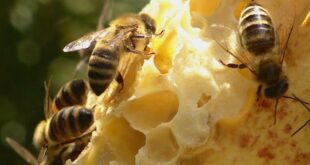Observations of Australian mosquitoes' feeding habits could pave way for frog conservation

John Gould had been snapping pictures of mosquitoes on frogs for years before he noticed a trend — the bloodsuckers always seem to land right on the amphibians' noses.
"You would think that a frog would be the worst place to land, because frogs love to eat mosquitoes," Gould, a behavioural biologist at Australia's University of Newcastle, told As It Happens host Nil Köksal.
Nevertheless, Gould has collected more than a dozen photos of mosquitoes in Australia on frog nostrils, leading him to conclude it's a "highly specialized feeding strategy" by the mosquitoes.
The observations — published in the journal Ethology — could even help scientists better understand how a deadly disease spread among frogs, which is key for their conservation.
A sneak attack from a strategic position
Gould has observed the insects perching on the nostrils of several different species of Australian tree frogs. But the mosquitoes are all from the same species, Mimomyia elegans. Native to Australia, they feed off many different kinds of animals, including mammals and birds.
"Which makes the observation a bit more interesting," Gould said, "because, for such a generalist feeder, it seems to have such a specialized behaviour when choosing amphibians as a blood host."
So why risk landing on the nose of something that wants to eat you, when there are so many other targets walking around full of delicious blood?
"In all of the occasions that we observed, it seems as if the frog didn't realize that it had a mosquito on top of it…. They were actually quite happy, just sitting idly, while these mosquitoes were feeding on them," Gould said.
"So it might be that the area between the eyes is a bit of a blind spot for the frogs."

It's also something of a sneak attack by the mosquitoes.
"Some of the mosquitoes first initially landed on the backs of the frogs," Gould said. "They might avoid being eaten by the frogs by landing away from the head and then walking up to the nostrils to feed."
It's a plausible theory, says amphibian expert Lea Randall, a Calgary Zoo and Wilder Institute ecologist who wasn't involved in the research.
"Frogs have amazing vision, and any mosquito that approached from the front would likely end up as a tasty snack for a frog," she said.
"Landing on the back and making your way undetected to the nostrils is a good strategy."
And the reward may just be worth the risk.
"I could also see the nostrils as being a good place to feed as the skin is very thin and highly vascularized, and thus provides a ready source of blood for a hungry mosquito," Randall said.
Still, she says she hasn't noticed the same phenomenon in her own observations of northern leopard frogs.
"This may be an evolutionary strategy that is limited to this species of mosquito in Australia," she said.
Conservation implications
Gould admits his friends and loved ones have likely grown weary of hearing him "talking about frogs and nostrils." But for him, it's more than a highly specific scientific obsession; it's about protecting frogs.
His earlier research has suggested that mosquitoes may be a vector for transmitting amphibian chytrid fungus, which is responsible for declines in frog populations worldwide.
That's why he had been amassing photos of frogs and mosquitoes in the first place.
"Now that we know where the mosquito is more likely to land, it might give us a better impression about how the infection spreads along the skin of the frog," he said.

But more work needs to be done. His frog nostril research, while it encompasses three years' of fieldwork, is a natural history observation, not a laboratory study with controlled variables.
"It would be quite interesting to know whether this particular type of mosquito is transferring the chytrid fungus, and also how the fungus spreads once the mosquito has landed," Gould said.
Randall welcomes any work that sheds light on the deadly fungus.
"It has led to the extinction of some amphibian species and has had a negative impact on many others. We maintain strict protocols within our amphibian breeding facilities to prevent the spread of chytrid fungus, but they are not mosquito-proof," she said.
"This is something I will be sharing within our organization and with our colleagues and I think should be a focus of research in Canada."

Add some “good” to your morning and evening.
A variety of newsletters you'll love, delivered straight to you.
*****
Credit belongs to : www.cbc.ca
 MaharlikaNews | Canada Leading Online Filipino Newspaper Portal The No. 1 most engaged information website for Filipino – Canadian in Canada. MaharlikaNews.com received almost a quarter a million visitors in 2020.
MaharlikaNews | Canada Leading Online Filipino Newspaper Portal The No. 1 most engaged information website for Filipino – Canadian in Canada. MaharlikaNews.com received almost a quarter a million visitors in 2020.







